Improving Indoor Thermal Comfort and Air-Conditioning Management in Representative Primary Schools in Southern China
Abstract
1. Introduction
2. Research Subjects Selection and Experimental Methods
2.1. Research Location and Description of the Experiment
2.2. Survey Questionnaire for Indoor Thermal Comfort in Primary School
2.3. Measurement of Indoor Thermal Environment in Primary School
2.4. Introduction to Human Thermal Comfort and Calculation Methods
| : the metabolic rate, in watts per square meter [W/] |
| : the effective mechanical pow, in watts per square meter [W/] |
| : the clothing insulation, in watts per square meter [·K/W] |
| : the clothing surface area factor |
| : the air temperature, in degrees Celsius [° C] |
| : the mean radiant temperature, in degrees Celsius [° C] |
| : the global temperature [° C] |
| : the clothing surface temperature, in degrees Celsius [° C] |
| : the relative air velocity, in meters per second [m/s] |
| : the convective heat transfer coefficient [W/(×K)] |
| : the partial vapor pressure [Pa] |
2.5. Application of Multiple Linear Regression Analysis in TSV Relationship Modeling
- Y is the dependent variable, representing the predicted value of the study object (in this study, it is TSV).
- X1, X2, …… Xn are the independent variables that may influence TSV (e.g., temperature, humidity).
- β0 is the intercept, indicating the predicted value when all independent variables are zero.
- β1, β2, …, βn are the regression coefficients, representing the influence of each independent variable on the dependent variable.
- ϵ is the random error term, capturing the variability that cannot be explained by the independent variables.
3. Results and Analysis
3.1. Results and Analysis of Survey Questionnaire
3.2. Results and Analysis of Measurement Data of Summer
3.3. Relationship Between PMV and TSV in Primary School Classrooms
3.4. Multiple Regression Analysis of TSV-Based Temperature and Humidity
- T represents indoor temperature (°C);
- TSVp represents predicted TSV;
- H represents indoor relative humidity (%).
3.5. Guidelines for Air-Conditioning Use in Summer Based on TSV Regression Analysis
4. Conclusions
- The results indicate that when TSV ≥ 1 (Hot or Very Hot), the proportion of PMV ≥ 0.5 is nearly identical. This demonstrates that TSV can effectively substitute PMV in evaluating indoor thermal comfort when environmental monitoring data are unavailable. TSV is derived directly from students’ subjective thermal perceptions, making it a more accessible and practical metric for assessing classroom thermal environments.
- To further improve the accuracy of TSV prediction, a refined multiple regression model was developed using the most recent dataset. The model confirmed that each 1 °C increase in indoor air temperature led to an approximate rise of 0.50 units in Thermal Sensation Vote, while each 1% increase in relative humidity contributed an additional 0.055 units. This indicates that temperature is the dominant factor influencing thermal perception, with humidity playing a notable secondary role. The model was particularly suited to summer conditions in hot summer and cold winter climate zones, providing a practical and efficient alternative to conventional PMV calculations.
- Building upon these findings, practical guidelines for air-conditioning usage were proposed to balance thermal comfort and energy efficiency. Temperature adjustment based on humidity is especially critical: although air temperature is the primary factor, high humidity—especially on rainy days—can make occupants feel warmer than the measured temperature suggests. Therefore, air-conditioning systems should not only provide cooling but also integrate dehumidification functions. To support this approach, a dynamic control strategy is recommended, incorporating smart thermostats and humidity sensors to enable real-time adjustment of indoor conditions. This ensures better responsiveness to occupant comfort while promoting sustainable energy use. For example, a recommended setpoint of 28 °C has been shown to provide a reasonable balance between thermal comfort and energy conservation, particularly when combined with active humidity control.
Author Contributions
Funding
Institutional Review Board Statement
Data Availability Statement
Conflicts of Interest
References
- Klepeis, N.E.; Nelson, W.C.; Ott, W.R.; Robinson, J.P.; Tsang, A.M.; Switzer, P.; Behar, J.V.; Hern, S.C.; Engelmann, W.H. The National Human Activity Pattern Survey (NHAPS): A resource for assessing exposure to environmental pollutants. J. Expo. Sci. Environ. Epidemiol. 2001, 11, 231–252. [Google Scholar] [CrossRef]
- Schweizer, C.; Edwards, R.D.; Bayer-Oglesby, L.; Gauderman, W.J.; Ilacqua, V.; Jantunen, M.J.; Lai, H.K.; Nieuwenhuijsen, M.; Künzli, N. Indoor timemicroenvironment-activity patterns in seven regions of Europe. J. Expo. Sci. Env. Epidemiol. 2006, 17, 170–181. [Google Scholar] [CrossRef]
- Li, J.; Wang, F. Applied research on energy-saving technology of buildings in hot summer and cold winter regions of China. Appl. Mech. Mater. 2014, 672–674, 1806–1810. [Google Scholar] [CrossRef]
- Liu, J. Research on Indoor Thermal Environment and Human Thermal Comfort of Naturally Ventilated Buildings in Hot Summer and Cold Winter Regions. Master’s Thesis, Chongqing University, Chongqing, China, 2007. (In Chinese) [Google Scholar] [CrossRef]
- Ye, X.; Zhou, Z.; Lian, Z.; Wen, Y.; Zhou, Z.; Jiang, C. Study on thermal comfort of neutral ventilated buildings in different city. Build. Energy Effici. 2007, 35, 55–57. (In Chinese) [Google Scholar] [CrossRef]
- Yi, T.; Wang, H.; Liu, C.; Li, X.; Wu, J. Thermal comfort differences between urban villages and formal settlements in Chinese developing cities: A case study in Shenzhen. Sci. Total Environ. 2023, 856, 158283. [Google Scholar] [CrossRef]
- Sun, Y.; Zhang, C.; Zhao, Y.; Li, J.; Ma, Y.; Zhu, C. A systematic review on thermal environment and thermal comfort studies in Chinese residential buildings. Energy Build. 2023, 291, 113134. [Google Scholar] [CrossRef]
- Ministry of Education of the People’s Republic of China. National Statistical Bulletin on the Development of Education of 2022; Ministry of Education of the People’s Republic of China: Beijing, China, 2023. [Google Scholar]
- Zomorodian, Z.S.; Tahsildoost, M.; Hafezi, M. Thermal comfort in educational buildings: A review article. Renew. Sustain. Energy Rev. 2016, 59, 895–906. [Google Scholar] [CrossRef]
- Djongyang, N.; Tchinda, R.; Njomo, D. Thermal comfort: A review paper. Renew. Sustain. Energy Rev. 2010, 14, 2626–2640. [Google Scholar] [CrossRef]
- Wargocki, P.; Wyon, D.P. Providing better thermal and air quality conditions in school classrooms would be cost-effective. Build. Environ. 2013, 59, 581–589. [Google Scholar] [CrossRef]
- Lee, M.C.; Mui, K.W.; Wong, L.T.; Chan, W.Y.; Lee, E.W.M.; Cheung, C.T. Student learning performance and indoor environmental quality (IEQ) in air-conditioned university teaching rooms. Build. Environ. 2012, 49, 238–244. [Google Scholar] [CrossRef]
- Yang, Z.; Becerik-Gerber, B.; Mino, L. A study on student perceptions of higher education classrooms: Impact of classroom attributes on student satisfaction and performance. Build. Environ. 2013, 70, 171–188. [Google Scholar] [CrossRef]
- De Giuli, V.; Da Pos, O.; De Carli, M. Indoor environmental quality and pupil perception in Italian primary schools. Build. Environ. 2012, 56, 335–345. [Google Scholar] [CrossRef]
- Mishra, A.K.; Ramgopal, M. Thermal comfort field study in undergraduate laboratories—An analysis of occupant perceptions. Build. Environ. 2014, 76, 62–72. [Google Scholar] [CrossRef]
- Turunen, M.; Toyinbo, O.; Putus, T.; Nevalainen, A.; Shaughnessy, R.; Haverinen-Shaughnessy, U. Indoor environmental quality in school buildings, and the health and wellbeing of students. Int. J. Hyg. Environ. Health 2014, 217, 733–739. [Google Scholar] [CrossRef]
- de Dear, R.J.; Akimoto, T.; Arens, E.A.; Brager, G.; Candido, C.; Cheong, K.W.D.; Li, B.; Nishihara, N.; Sekhar, S.C.; Tanabe, S.-I.; et al. Progress in thermal comfort research over the last twenty years. Indoor Air 2013, 23, 442–461. [Google Scholar] [CrossRef]
- Auliciems, A. Thermal requirements of secondary schoolchildren in winter. J. Hyg. 1969, 67, 59–65. [Google Scholar] [CrossRef]
- van Hoof, J. Forty years of Fanger’s model of thermal comfort: Comfort for all? Indoor Air 2008, 18, 182–201. [Google Scholar] [CrossRef]
- Yang, L.; Yan, H.; Lam, J.C. Thermal comfort and building energy consumption implications—A review. Appl. Energy 2014, 115, 164–173. [Google Scholar] [CrossRef]
- Yau, Y.; Chew, B. A review on predicted mean vote and adaptive thermal comfort models. Build. Serv. Eng. Res. Technol. 2012, 35, 23–35. [Google Scholar] [CrossRef]
- Huang, K.-T.; Huang, W.-P.; Lin, T.-P.; Hwang, R.-L. Implementation of green building specification credits for better thermal conditions in naturally ventilated school buildings. Build. Environ. 2015, 86, 141–150. [Google Scholar] [CrossRef]
- Babaharra, O.; Choukairy, K.; Faraji, H.; Khallaki, K.; Hamdaoui, S.; Bahammou, Y. Thermal performance analysis of hollow bricks integrated phase change materials for various climate zones. Heat Transf. 2024, 53, 2148–2172. [Google Scholar] [CrossRef]
- Martinez-Molina, A.; Boarin, P.; Tort-Ausina, I.; Vivancos, J.-L. Post-occupancy evaluation of a historic primary school in Spain: Comparing PMV, TSV and PD for teachers’ and pupils’ thermal comfort. Build. Environ. 2017, 117, 248–259. [Google Scholar] [CrossRef]
- Huang, K.T.; Hwang, R.L. Parametric study on energy and thermal performance of school buildings with natural ventilation, hybrid ventilation and air conditioning. Indoor Built Environ. 2016, 25, 1148–1162. [Google Scholar] [CrossRef]
- EN 15251:2007; Indoor Environmental Input Parameters for Design and Assessment of Energy Per-Formance of Buildings Addressing Indoor Air Quality, Thermal Environment, Lighting and Acoustics. Comité European de Normalisation: Brussels, Belgium, 2007.
- EN ISO 7730:2005; Ergonomics of the Thermal Environment—Analytical Determination and Interpretation of Thermal Comfort Using Calculation of the Pmv and Ppd Indices and Local Thermal Comfort Criteria. ISO: Geneva, Switzerland, 2005.
- ANSI/ASHRAE Standard 55-2013; Thermal Environmental Conditions for Human Occupancy. ASHRAE: Peachtree Corners, GA, USA, 2013.
- Yun, H.; Nam, I.; Kim, J.; Yang, J.; Lee, K.; Sohn, J. A field study of thermal comfort for kindergarten children in Korea: An assessment of existing models and preferences of children. Build. Environ. 2014, 75, 182–189. [Google Scholar] [CrossRef]
- Liang, H.-H.; Lin, T.-P.; Hwang, R.-L. Linking occupants’ thermal perception and building thermal performance in naturally ventilated school buildings. Appl. Energy 2012, 94, 355–363. [Google Scholar] [CrossRef]
- Auliciems, A. Classroom performance as a function of thermal comfort. Int. J. Biometeorol. 1972, 16, 233–246. [Google Scholar] [CrossRef] [PubMed]
- Auliciems, A. Warmth and comfort in the subtropical winter: A study in brisbane schools. J. Hyg. 1975, 74, 339–343. [Google Scholar] [CrossRef]
- Humphreys, M. A study of the thermal comfort of primary school children in summer. Build. Environ. 1977, 12, 231–239. [Google Scholar] [CrossRef]
- Kwok, A.G. Thermal comfort in tropical classrooms. ASHRAE Trans. 1998, 104, 1031–1050. [Google Scholar]
- Lewis, R. A survey of metaheuristic-based techniques for university timetabling problems. OR Spectr. 2007, 30, 167–190. [Google Scholar] [CrossRef][Green Version]
- Qu, R.; Burke, E.K.; McCollum, B.; Merlot, L.T.G.; Lee, S.Y. A survey of search methodologies and automated system development for examination timetabling. J. Sched. 2008, 12, 55–89. [Google Scholar] [CrossRef]
- Go, I. Indoor Air Quality and Thermal Environment in Classrooms of An Elementary School during Summer Season before/after Installing air Conditioner. J. Environ. Eng. 2009, 74, 877–882. [Google Scholar] [CrossRef]
- Kaihara, N.; Hayashi, M.; Kim, H.; Osawa, H.; Bando, M.; Kobayashi, K.; Honma, Y.; Yan, S.; Kikuta, K.; Hayama, H. State of indoor thermal environment in special nursing homes for the elderly: Measurement of indoor temperature and humidity, and analysis of humidity control in winter in cold regions. J. Environ. Eng. (Trans. AIJ) 2018, 83, 267–276. [Google Scholar] [CrossRef][Green Version]
- Fanger, P.O. Thermal Comfort: Analysis and Applications in Environmental Engineering; Danish Technical Press: Copenhagen, Denmark, 1970. [Google Scholar]
- Ole Fanger, P.; Toftum, J. Extension of the pmv model to non-air-conditioned buildings in warm climates. Energy Build. 2002, 34, 533–536. [Google Scholar] [CrossRef]
- Cheung, T.; Schiavon, S.; Parkinson, T. Analysis of the accuracy on thermal sensation models using ASHRAE Global Thermal Comfort Database II. Build. Environ. 2019, 153, 205–217. [Google Scholar] [CrossRef]
- Mazzone, A.; Khosla, R. Socially Constructed or Physiologically Informed? Placing Humans at the Core of Understanding Cooling Needs. Energy Res. Soc. Sci. 2021, 81, 102088. [Google Scholar] [CrossRef]



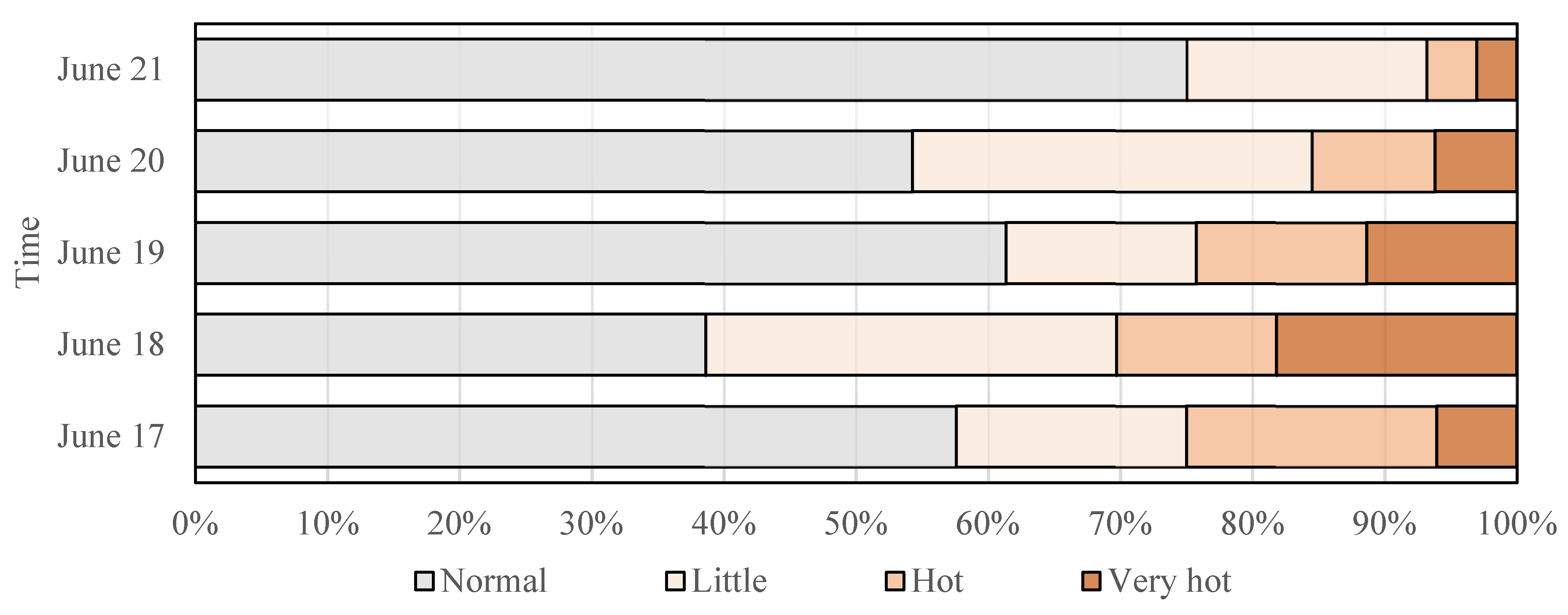

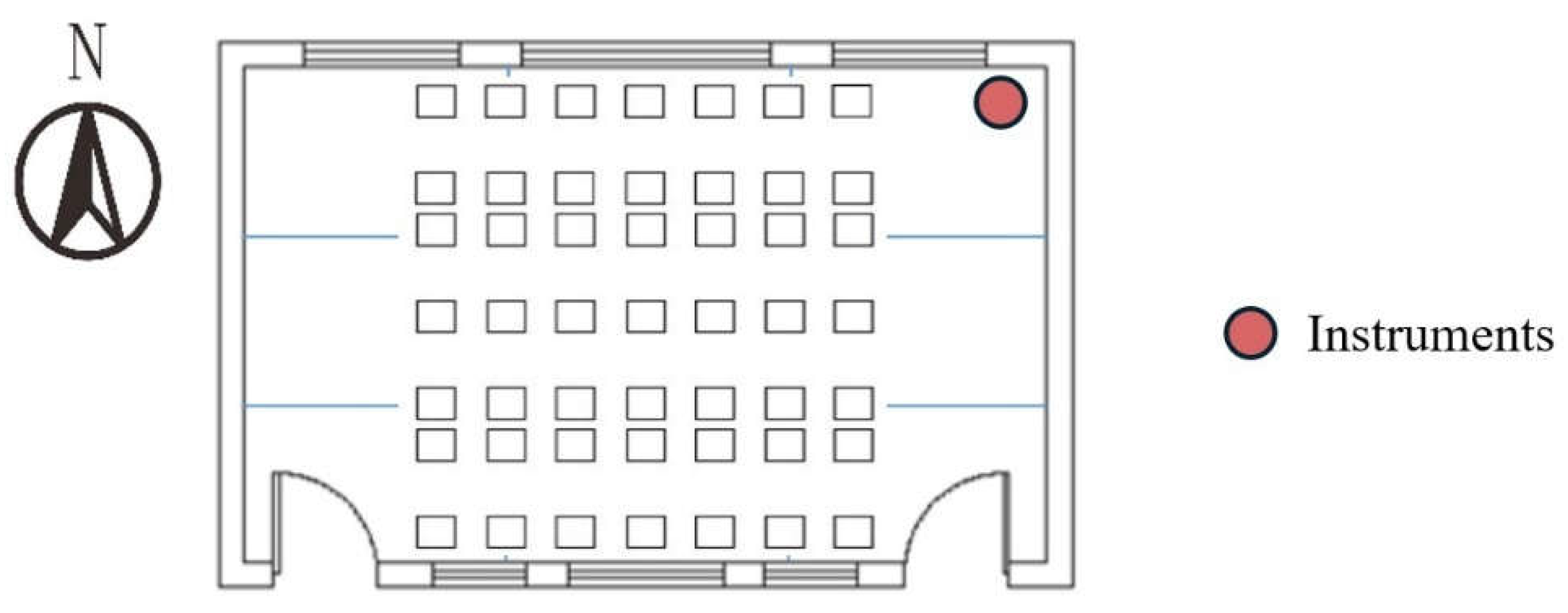
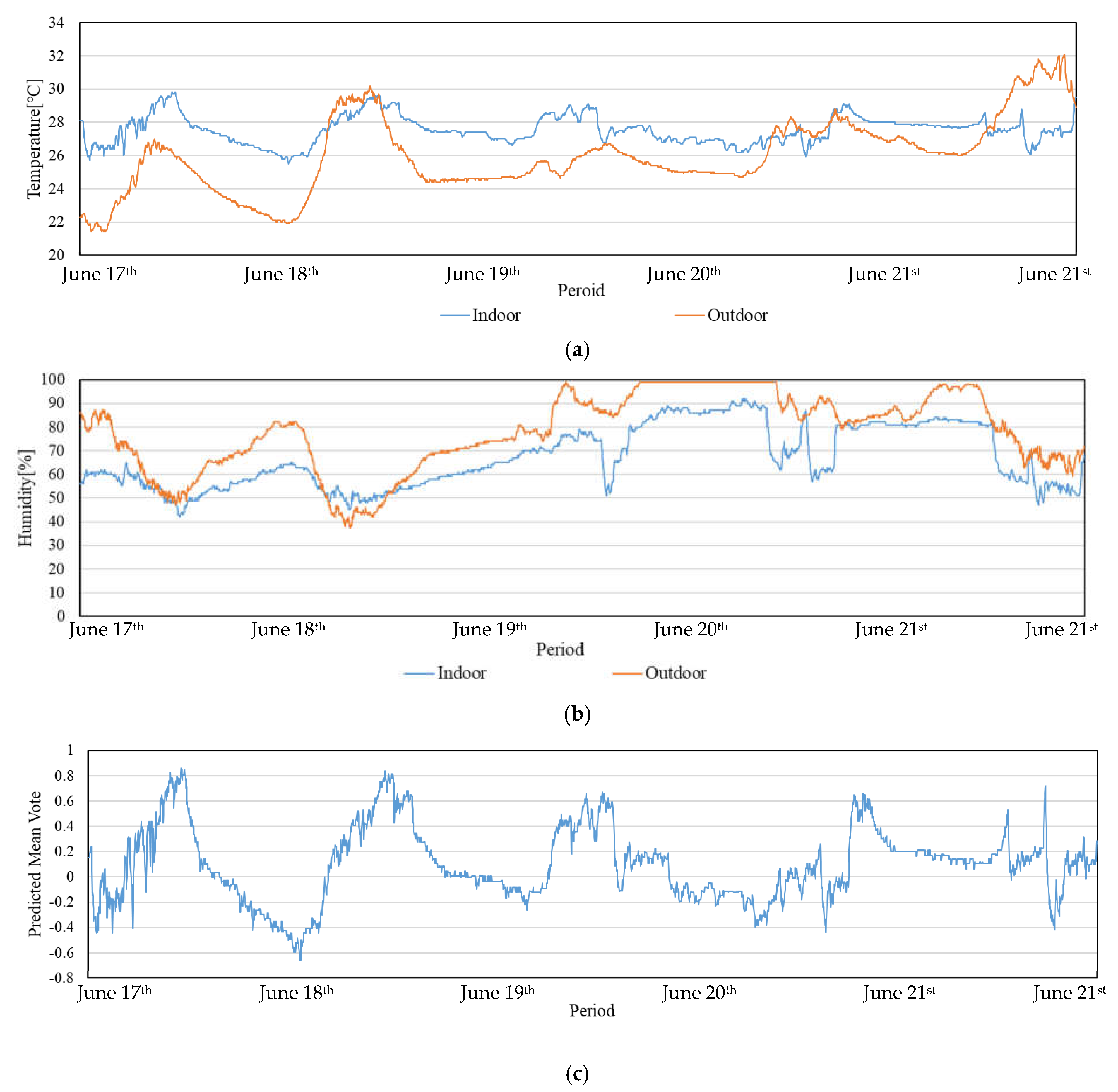

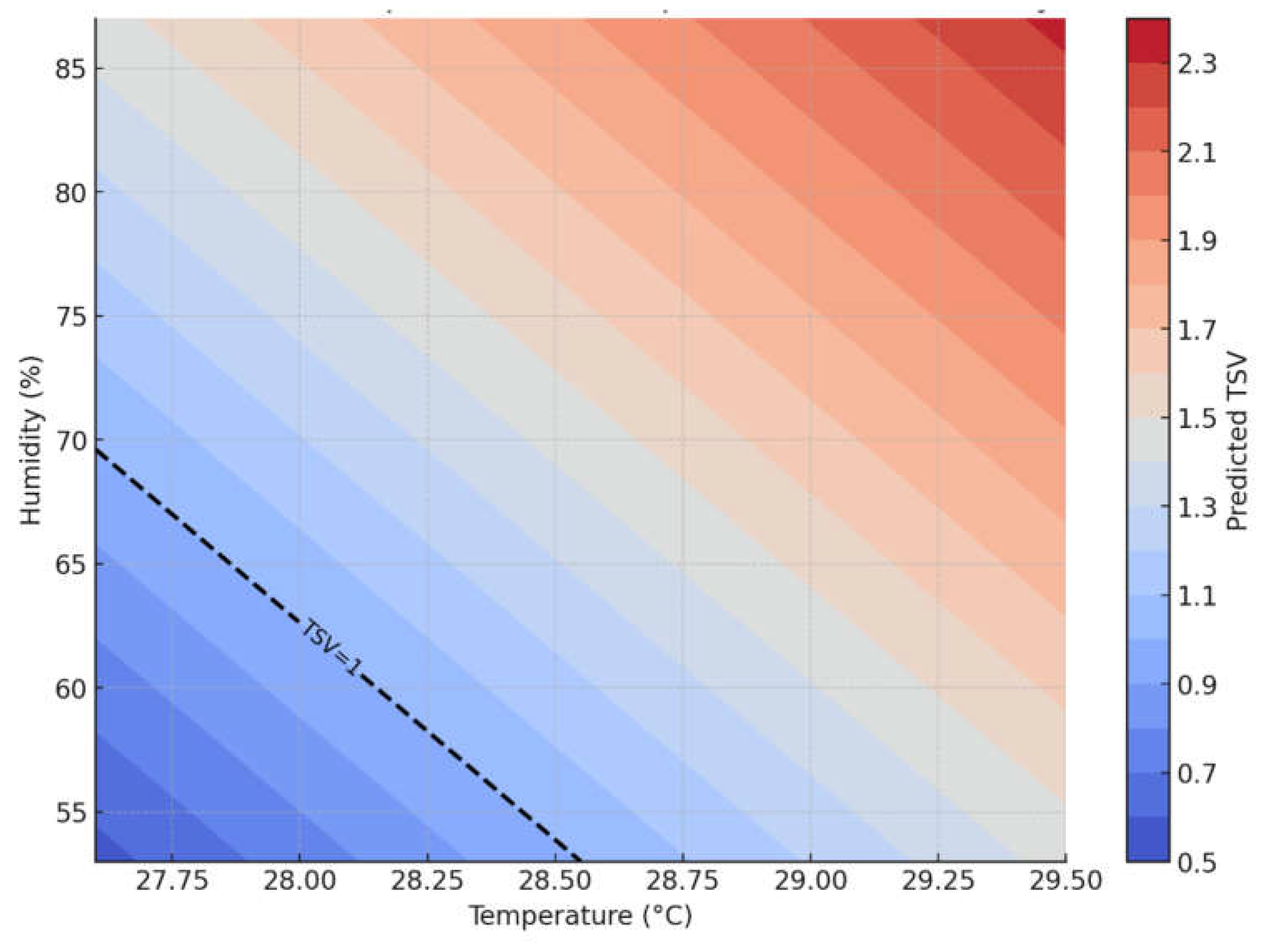
| Season | Climate | Average Temperature (Last Decade) |
|---|---|---|
| Spring | Humid and sunny | Highest: 23 °C, Lowest: 9 °C |
| Summer | Humid, chilly, and cloudy | Highest: 33 °C, Lowest: 22 °C |
| Autumn | Humid and chilly | Highest: 28 °C, Lowest: 17 °C |
| Winter | Humid and sunny | Highest: 16 °C, Lowest: 4 °C |
| School Name | A |
|---|---|
| Student Numbers | 2975 |
| Structure | RC |
| Completion | Year: 2008 |
| Floors | 4 |
| Cooling System | Fan and air-conditioner |
| Ventilation System | Not available |
| Facility | Number | Materials/Type |
|---|---|---|
| Window | 6 | Double Low-E |
| Electric Fans | 4 | Ceiling |
| Air Conditioner | 1 | Wall-mounted |
| Desk | 45 | Metal and Wood |
| Chair | 45 | Metal and Wood |
| Ventilation System | Not available | Airflow relied on manual window opening |
| Question | Options |
|---|---|
| 1. Please select your seat in the figure below. |  |
| 2. Sex | □ Male □ Female |
| 3. Do you feel hot in the classroom during the summer? |  |
| 4. Do you often feel that the air in the classroom is humid and sticky? |  |
| TSV Index | Response |
|---|---|
| 0 | 0 star ≤ Response ≤ 1 star |
| 1 | 1 star < Response ≤ 2 stars |
| 2 | 2 stars < Response ≤ 3 stars |
| 3 | 3 stars < Response ≤ 4 stars |
| Instrument Name | Instrument | On-Site Photos | Measurement Range | Measurement Parameters |
|---|---|---|---|---|
| Tr-45 (Company: T&D Corporation, Tokyo, Japan) | 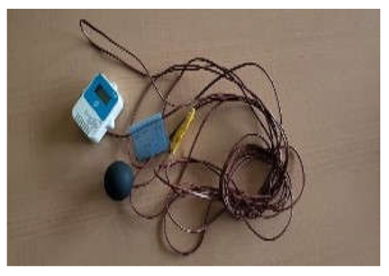 |  | Temp.: −20 °C–70 °C | Black Ball Temperature |
| Tr-72Ui (Company: T&D Corporation, Tokyo, Japan) | 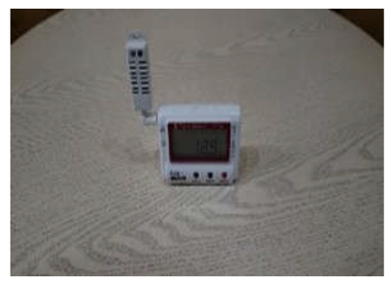 |  | Temp.: −20 °C–60 °C Humidity: 0–100% | Air Temperature Humidity |
| Tr-76Ui (Company: T&D Corporation, Tokyo, Japan) |  |  | Temp.: −20 °C–60 °C Humidity: 0–100% CO2: 0 ppm–9999 ppm | Air Temperature Humidity Carbon Dioxide Concentration |
| Anemometer (Company: UNUO, Tokyo, Japan) |  | 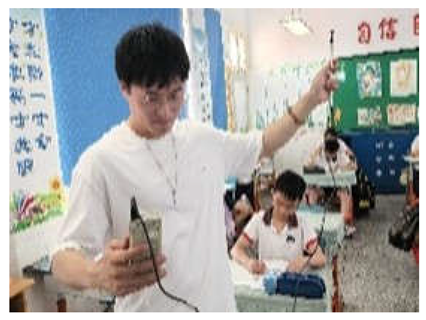 | Speed: 0 m/s–20 m/s | Air Velocity |
| Classroom | Site | Student Num. | Area | Per Capita Density |
|---|---|---|---|---|
| Selected | Fourth, West | 44 | 36.48 m2 | 0.59 m2 |
| Date | Moment | Indoor Temperature | Indoor Humidity | Air-Conditioning Use |
|---|---|---|---|---|
| June 17th | 9:00 am | 26.4 °C | 61% | Close |
| 12:00 am | 28.0 °C | 61% | Close | |
| 16:00 pm | 29.5 °C | 53% | Close | |
| June 18th | 9:00 am | 27.6 °C | 52% | Close |
| 12:00 am | 29.4 °C | 49% | Close | |
| 16:00 pm | 29.0 °C | 53% | Close | |
| June 19th | 9:00 am | 28.5 °C | 69% | Close |
| 12:00 am | 28.6 °C | 79% | Close | |
| 16:00 pm | 27.6 °C | 65% | Open | |
| June 20th | 9:00 am | 27.1 °C | 62% | Close |
| 12:00 am | 27.8 °C | 87% | Open, then closed | |
| 16:00 pm | 28.6 °C | 82% | Open, then closed | |
| June 21st | 9:00 am | 27.6 °C | 60% | Open |
| 12:00 am | 28.6 °C | 68% | Close | |
| 16:00 pm | 27.5 °C | 53% | Open |
| Statistic | Variable 1 | Variable 2 |
|---|---|---|
| Mean | 1.403963 | 0.351209 |
| Variance | 1.407557 | 0.082166 |
| Observations | 656 | 656 |
| Pearson Correlation | 0.205226 | - |
| Hypothesized Mean Difference | 0 | - |
| Degrees of Freedom | 655 | - |
| t-Statistic | 23.2055 | - |
| p (T <= t) One-Tail | 1.06 × 10−87 | - |
| t Critical One-Tail | 1.6472 | - |
| p (T <= t) Two-Tail | 2.12 × 10−87 | - |
| t Critical Two-Tail | 1.9636 | - |
| Statistic | Value |
|---|---|
| Multiple R | 0.536 |
| R Square | 0.287 |
| Adjusted R Square | 0.279 |
| Standard Error | 1.083 |
| Observations | 190 |
| Variable | Coefficient | Standard Error | T-Stat | p-Value |
|---|---|---|---|---|
| Intercept | −17.120 | 3.669 | −4.394 | 1.87 × 10−5 |
| Temperature | 0.499 | 0.123 | 4.060 | 7.21 × 10−5 |
| Humidity | 0.055 | 0.006 | 8.596 | 3.25 × 10−15 |
| Day Type | Indoor Humidity Range | Temperature at TSV = 1 |
|---|---|---|
| Rainy | ~87% | 26.7 °C~ |
| Cloudy | ~70% | 28.5 °C~ |
| Sunny | ~58% | 29.9 °C~ |
| In Air-Con | ~75% | 28.0 °C~ |
| Day Type | Sunny | Cloudy | Rainy |
|---|---|---|---|
| Recommended Opening Temperature | 29.9 °C | 28.5 °C | 26.7 °C |
| Recommended Temperature Setting | 28 °C | 28 °C | 28 °C |
Disclaimer/Publisher’s Note: The statements, opinions and data contained in all publications are solely those of the individual author(s) and contributor(s) and not of MDPI and/or the editor(s). MDPI and/or the editor(s) disclaim responsibility for any injury to people or property resulting from any ideas, methods, instructions or products referred to in the content. |
© 2025 by the authors. Licensee MDPI, Basel, Switzerland. This article is an open access article distributed under the terms and conditions of the Creative Commons Attribution (CC BY) license (https://creativecommons.org/licenses/by/4.0/).
Share and Cite
Sun, Y.; Ando, W.; Kojima, S.; Nakaohkubo, K. Improving Indoor Thermal Comfort and Air-Conditioning Management in Representative Primary Schools in Southern China. Processes 2025, 13, 1538. https://doi.org/10.3390/pr13051538
Sun Y, Ando W, Kojima S, Nakaohkubo K. Improving Indoor Thermal Comfort and Air-Conditioning Management in Representative Primary Schools in Southern China. Processes. 2025; 13(5):1538. https://doi.org/10.3390/pr13051538
Chicago/Turabian StyleSun, Yicheng, Wataru Ando, Shoichi Kojima, and Kazuaki Nakaohkubo. 2025. "Improving Indoor Thermal Comfort and Air-Conditioning Management in Representative Primary Schools in Southern China" Processes 13, no. 5: 1538. https://doi.org/10.3390/pr13051538
APA StyleSun, Y., Ando, W., Kojima, S., & Nakaohkubo, K. (2025). Improving Indoor Thermal Comfort and Air-Conditioning Management in Representative Primary Schools in Southern China. Processes, 13(5), 1538. https://doi.org/10.3390/pr13051538







